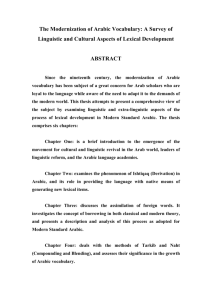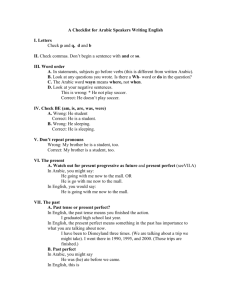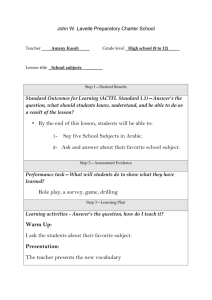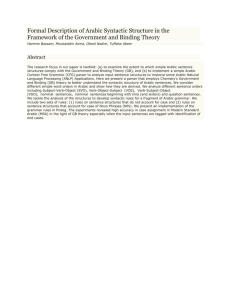Typology of Motion Event in Tunisian Arabic
advertisement
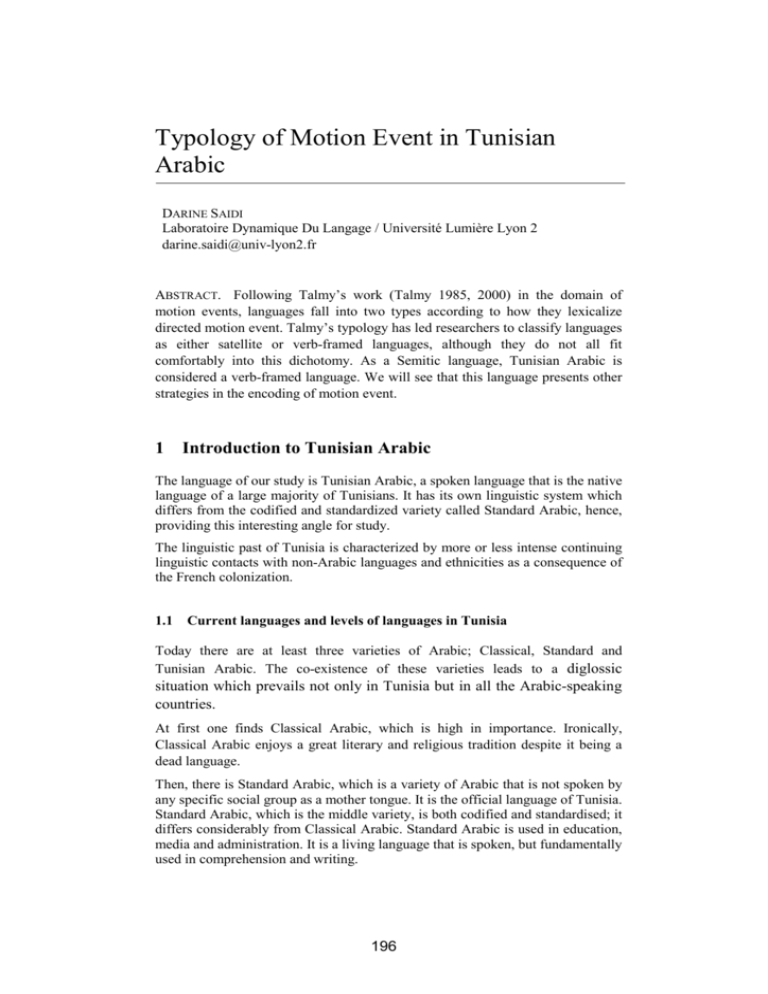
Typology of Motion Event in Tunisian Arabic DARINE SAIDI Laboratoire Dynamique Du Langage / Université Lumière Lyon 2 darine.saidi@univ-lyon2.fr ABSTRACT. Following Talmy’s work (Talmy 1985, 2000) in the domain of motion events, languages fall into two types according to how they lexicalize directed motion event. Talmy’s typology has led researchers to classify languages as either satellite or verb-framed languages, although they do not all fit comfortably into this dichotomy. As a Semitic language, Tunisian Arabic is considered a verb-framed language. We will see that this language presents other strategies in the encoding of motion event. 1 Introduction to Tunisian Arabic The language of our study is Tunisian Arabic, a spoken language that is the native language of a large majority of Tunisians. It has its own linguistic system which differs from the codified and standardized variety called Standard Arabic, hence, providing this interesting angle for study. The linguistic past of Tunisia is characterized by more or less intense continuing linguistic contacts with non-Arabic languages and ethnicities as a consequence of the French colonization. 1.1 Current languages and levels of languages in Tunisia Today there are at least three varieties of Arabic; Classical, Standard and Tunisian Arabic. The co-existence of these varieties leads to a diglossic situation which prevails not only in Tunisia but in all the Arabic-speaking countries. At first one finds Classical Arabic, which is high in importance. Ironically, Classical Arabic enjoys a great literary and religious tradition despite it being a dead language. Then, there is Standard Arabic, which is a variety of Arabic that is not spoken by any specific social group as a mother tongue. It is the official language of Tunisia. Standard Arabic, which is the middle variety, is both codified and standardised; it differs considerably from Classical Arabic. Standard Arabic is used in education, media and administration. It is a living language that is spoken, but fundamentally used in comprehension and writing. 196 Typology of Motion Event in Tunisian Arabic Finally, one finds Tunisian Arabic, which is considered as the low variety given that it is neither codified nor standardised and even though it is the mother tongue and the variety spoken by all the population in daily usage. There are regional variants at phonological and lexical level. Apart from the regional varieties, one also finds social and individual variations. There are also variations related to a more or less strong influence of Standard Arabic and French. Tunisian Arabic and Standard Arabic differ in phonological, morphosyntactic and lexical level given their differences in use and nature (standardized vs. nonstandardized, rather written vs. rather spoken). Standard Arabic is held on a fixed code while Tunisian Arabic uses different mechanisms (such as lexicalization, analogy, metaphor) for the denomination of new realities. Indeed, one notices a great creativity in Tunisian Arabic owing to numerous loaned words, the adaptation to new realities and trends and to its character of being an oral and non-standardized language. We have already underlined the dynamism and richness of this system and the fact that it has rarely been studied (especially at the morphosyntactic level). There are many differences at the phonological, lexical and of course morphosyntactic levels between Standard Arabic and Tunisian Arabic (e.g. word order VSO in Standard Arabic vs. SVO in Tunisian Arabic). In addition to the three varieties of Arabic mentioned before, one finds French as a language of communication and of prestige in daily usage. This language exerts a considerable influence on Tunisian Arabic at all linguistic levels. 1.2 A complex linguistic situation in Tunisia The post-colonial epoch is still politically changeable in the fundamental choices, notably in the linguistic domain. This leads to a fluctuating and dynamic linguistic situation. Another reason for this complexity is the Tunisian linguistic situation itself. On the one hand, diglossia can be found: Standard Arabic – Tunisian Arabic (both Standard and so-called “dialectal” levels have their own system). On the other hand, there is bilingualism: Arabic – French (two languages belonging to different linguistic families). 2 The study of motion event in Tunisian Arabic As mentioned before, Tunisian Arabic is an oral and non-codified language submitted to many variations. This influences strongly the structure of the language. Within this system the expression of motion events will be examined through the typology of motion events proposed by Talmy (Talmy 1985) and Slobin (Slobin 2004). A language provides its speaker with a range of ways of describing motion events, that is, combinations of lexical items and grammatical morphemes in 197 Proceedings of LingO 2007 various construction types. The aim of this study is to consider the place of Tunisian Arabic in a general typology of motion events. 2.1 Talmy’s Typology of Motion Event A motion event is an event where an entity moves from place to place, or is identified as located at a particular place. It may be divided into a number of basic conceptual pieces: the Figure or moving entity, the Ground or landscape against which it moves, the Motion itself, and the Path along which it moves. We may also identify the Manner of its movement; (e.g., running, sliding, bouncing, tumbling etc.). The study of motion events examines the way a language encodes linguistically this particular semantic domain. The main objective of Talmy’s typology of motion event is, on the one hand, to examine systematic relations between the different semantic elements in a motion event (path, figure, ground etc) and, on the other hand, to classify languages according to the morphosyntactic tools used to encode the notion of path (Talmy 1991). Thus, languages are compared and grouped according to how they package all these semantic components into linguistic forms. In addition, languages can be divided into path-type, manner-type and figuretype, depending on their preferences in the lexicalization of these semantic elements in the root of their motion verbs. It is the first version of Talmy’s typology of motion event, but it will not be developed here. Languages also vary as to whether path or manner is coded as the head of the verb phrase, and what is coded as a verbal dependent. Furthermore, a second version of Talmy’s typology, one concerning the notion of path, will be examined. This typology is based on the morphosyntactic distribution of the semantic elements used by a language to encode Path. His twoway typology is based on the observation that path is the most likely component of a motion event to be expressed overtly. In his later work, Talmy (1991) picked out Path as the ‘core schema’ of motion events, and categorized languages based on how they expressed Path. The first type is called Verb-framed languages. These are languages with Path in the verb root. Manner and Ground information, if present, occur in separate clause. This group includes, for example, Romance, Semitic (which may include Tunisian Arabic) and Polynesian languages. It is illustrated in the French example (1): (1) L’enfant sort de The child goes out of The child runs out from the school. l’école en courant. the school running. In this example, the French motion verb ‘goes out’ encodes path as the child moves from the inside of the school towards outside, while manner is expressed in a gerund. 198 Typology of Motion Event in Tunisian Arabic The second type is Satellite-framed languages. These are languages which encode Path in a satellite (that is, a verbal dependant). This type includes English, some other Indo-European languages and Chinese as exemplified in the English example (2): (2) He runs away from the house. In example (2), the English verb to run encodes manner while path is expressed by the satellite ‘away’. Having given a short exposition of Talmy’s typology, we will now examine the classification of Tunisian Arabic within this typology. 2.2 Typological complexity of Tunisian Arabic in the expression of Motion According to Talmy’s typology, Semitic languages and therefore Tunisian Arabic are defined as verb-framed languages. The particularity of such languages is to encode path in the main verb and to express manner, if present, in a separate clause. The problem is that the en bloc classification of “Semitic languages” remains probably on the basis of the study of only one of these languages: Hebrew. However, other linguistic families split between several strategies. Then we may ask whether all the Semitic languages present the same strategies. In addition, this en bloc classification immediately evokes a certain number of questions: Such as, within Semitic languages, to which "Arabic" is one referring (standard or so-called “dialectal”, and in the latter case, of which country, which region)? These questions have all the more relevancy as shall be shown that we cannot simply classify Tunisian Arabic into verb-framed languages. One will see that some other strategies of Tunisian Arabic do not correlate with Talmy’s typology, and the fact that different types are not exclusive. This language cannot simply be classified as verb-framed because it also uses other strategies. Neither can one simply classify Tunisian Arabic as a satelliteframed language because one will see that the verbal prefixes are not considered as satellites (that is, verbal dependents). Finally, one will see that there are many other strategies used by Tunisian Arabic which do not fit into Talmy’s typology. One may ask whether Tunisian Arabic is a verb-framed language and it shall be shown that the answer to this question is not a simple one. 199 Proceedings of LingO 2007 Indeed, many examples of verb-framed constructions can be found in Tunisian Arabic, as is in example 3 below (3) it-tfol ræ DEF-child PAST-exit.3MSG The child exited from the school. mi from l-mædrsæ DEF-school In this example, the path, that is, the exit of the child from the school, is encoded in the main verb of the clause ‘exit’. However, this language uses other strategies as well, which do not correlate with Talmy’s dichotomy (that is, verb-framed vs. satellite-framed languages). We will examine it latter. Finally, as expected, it can be said that Tunisian Arabic is a verb-framed language, but one will see that it additionally has other structures which Talmy’s binary typology do not take into account. If Tunisian Arabic is not prototypically verb-framed, can one find satelliteframed structures in this language? Although this can be found in Tunisian verbal prefixes giving indications about motion event, they are not part of our study because they do not encode path but only manner. As a consequence, these prefixes do not fit into the satellite-framed category of Talmy. (4) a. it-tfol je-mi DEF-child PST-M.walk3SG The child walks in the street. b. it-tfol je-t-mææ DEF-child PST-M.-manner-walk3SG The child goes for a walk in the street. fi in e-æri DEF-street fi in e-æri DET-street In (4a), the Tunisian verb ‘walk’ encodes only path while the same verb in (4b), to which we added the prefix t, conflates manner and path. These prefixes, which can be found in some Tunisian verbs, encode manner (for example, the Tunisian verbs ‘walk’ vs. ‘go for a walk’, ‘wobble’ vs. ‘flit’, etc). These prefixes do not encode path and therefore they do not fit into Talmy’s category of satellite-framed structures. Consequently, it seems that one cannot consider Tunisian as a satellite-framed language. It is however a structure which encodes the expression of motion and a typology of this domain should be able to take it into account. Other strategies that encode path and which are not taken into account by Talmy’s typology will now be examined. First, to encode the notion of path, Tunisian Arabic uses a sequence active participle + verb which does not fit into Talmy’s categories, because participles are not considered as satellites. (5) it-tfol dæil je-r-i li DEF-child PART.A.enter.3MSG PST.M-run-3SG to 200 l-madisæ DET-school Typology of Motion Event in Tunisian Arabic The child is entering the school by running. In this example, the path is encoded in the active participle, a derived form from the verb ‘to enter’, while manner is encoded in the verb ‘to run’. The type of lexicalization is the following: A.PART [Motion and path] + V [Motion and manner]. Secondly, Tunisian also expresses path and Manner by using a single verb (without any other constituent in the same clause). It is a phenomenon of “semantic fusion” which again demonstrates a loophole in Talmy’s typology. In the following example, the Tunisian verb could be translated as ‘escape discreetly’. This verb encodes the crossing from one space to another (that is, from the bottle towards outside). It encodes the manner as well (that is, how the frog exited from the bottle). We can consider this case as a 'semantic fusion' within the verb [motion + path + manner]. (6) i-ranæ fs-it mne DEF-frog PAST.escape.discreetly-3FSG from The frog escaped from the bottle. e-ddæbbuzæ DEF-bottle It appears that Tunisian Arabic belongs to the verb-framed category, since the “core schema”, that is, Path, is often expressed by main verbs. On closer inspection, however, one should bring to light that some of these verbs can be followed by a Manner verb in the same clause. Hence, we have V1+V2 structures. Indeed, Tunisian Arabic also expresses Path by means of a "series" of two verbs, one encoding the path and the other encoding the manner. It cannot be considered as a verb-framed strategy since there are two verbal roots in the same clause. (7) it-tfol dæl je-r-i li l-madirsæ DET-child PAST.enter.3MSG PST.M-run-3SG to DET-school The child entered the school by running. In example (7), path is expressed by the verb ‘enter’ which represents the passing from inside towards the outside. The manner of motion is expressed in a second verb, 'to run'. Therefore, we have the following lexicalized pattern: V1 [Motion and Path] +V2 [Motion and Manner] 2.3 Can we consider V1 + V2 constructions as complex predicates or “verbal series”? In the previous example (7) we have a juxtaposition of verbs with the same subject, one expresses path and the other one encodes manner. Since then, there is a speculation on where to classify these kinds of “complex predicates”. One may reinterpret this structure as: Complex Predicate [path + manner]. Concerning these structures which appear as “complex predicates”, we already underlined the fact that they do not fall into Talmy’s typology of motion event. 201 Proceedings of LingO 2007 Slobin (2004) spreads this typology by adding a third type to the two existing ones. He called it “equipollently-framed languages”, in which both manner and path are expressed by so-called “equipollent” elements, that is, “elements that are equal in force or significance”. It includes serial verb languages and other types of languages with bipartite verb, etc. But, according to Fortis (2007), the relevance of the term equipollent is not always clear (e.g. there is often a fixed order). The cases of equipollence seem to be more restricted than Slobin intended it. It seems that Tunisian Arabic’s “complex predicates” cannot be classified into this third type. Indeed, as illustrated in example (7), the verb which expresses manner always comes after the path verb, in the case of Tunisian “complex predicates”, while in equipollent-framed languages the manner verb precedes inevitably the verb encoding path. 3 Conclusion This brief typological analysis leads us on the one hand to reconsider the en bloc classification of Semitic languages as verb-framed languages as regards Talmy’s typology of motion event. Indeed, although Tunisian Arabic appears, as expected, to be strongly verb-framed, there are many other strategies which were not taken into account by Talmy’s typology. Furthermore, this typology appears to be too clear-cut, whereas languages seem to be better described in terms of tendencies. Hence Slobin's suggested revision of Talmy’s typology with regards to manner of motion (not path). For Slobin it is more useful to rank languages on a cline of manner salience than to allocate them to one or several distinct typological categories. Indeed, one should not limit the study of motion event to Path. There are other semantic components to be taken into account. In addition, it has been shown that certain strategies used by Tunisian Arabic for the encoding of path do not fit into any of the typologies, neither that of Talmy, nor that of Slobin, briefly introduced in this presentation. Languages allow many other options to distribute the spatial information. And even within the same typological group, languages differ in the expression and the degree of lexical elaboration of the main semantic components of motion. Finally, the morphosyntactic criteria are not enough to report the various strategies used for the expression of motion, especially in the case of spoken and non-codified languages such as Tunisian Arabic where we find various additional options depending on intralinguistic variations. The interaction between the semantics of the various constituents of a spatial event and pragmatics (that is inferences) seems to be necessary for a study of the typological strategies of Tunisian Arabic and languages in general. 202 Typology of Motion Event in Tunisian Arabic References Fortis. J.-M. (2007). Typologie de l’expression linguistique du déplacement : un examen critique. Séminaire Formes Symboliques. Retrieved February 13, 2007, from http://htl.linguist.jussieu.fr/jmfortis.htm. Slobin, D.I. (2004). The many ways to search for a frog: linguistic typology and the expression of motion events. In S. Strömqvist & L. Verhoeven, (Eds.), Relating events in narratives (vol. 2): typological and contextual perspectives. Mahwah, New Jersey: Lawrence Erlbaum Associates. Talmy, L. (1985). Lexicalization patterns: semantic structure in lexical form. In T. Shopen (Ed.), Linguistic Typology and Syntactic Description: Grammatical Categories and the Lexicon. Cambridge: Cambridge University Press. Talmy, L. (1991). Path to realization: a typology of event conflation. Proceedings of the Seventeenth Annual Meeting of the Berkeley Linguistics Society, University of California, Berkeley. Berkeley Linguistics Society. Talmy, L. (2000). Toward a cognitive semantics, 2 vol. Cambridge, MA: M.I.T. Press. 203



